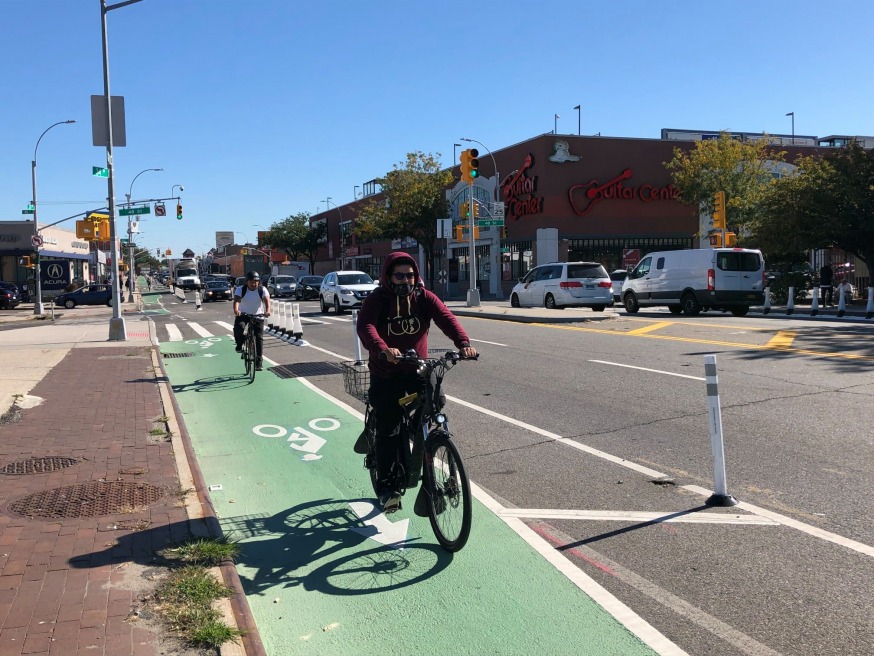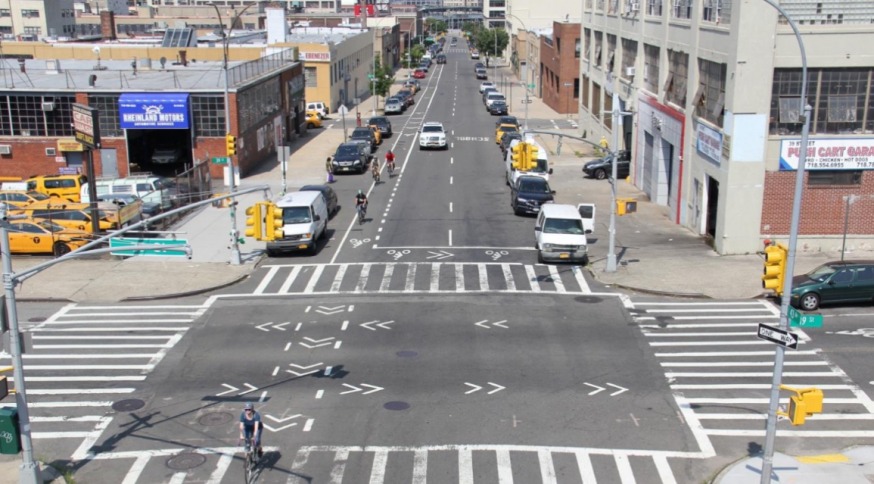
The Northern Boulevard protected bike lane. Protected bicycle lanes are painted green and are separated from vehicular traffic by open space, vertical delineation or a barrier (Photo: DOT)
Oct. 21, 2021 By Max Parrott
The city Department of Transportation Wednesday marked the completion of 4 miles of protected bike lanes on Northern Boulevard with the release of a bike safety study that touts the benefits of both protected and painted bike lanes.
The new study, entitled “Safe Streets for Cycling: How Street Design Affects Bicycle Safety and Ridership” used crash data over the past three years to find that protected bike lanes reduce risk of injury by 34 percent, and painted/conventional lanes lowered risk by 32 percent citywide.
In Queens, however, protected bike lanes added an even higher level of protection than the citywide average, reducing risk 40 percent. On the highest risk streets, cyclist risk is reduced by over 60 percent citywide, the study reported.
DOT Commissioner Hank Gutman released the report while visiting the protected bike lanes along Northern Boulevard that the agency has recently completed.
The boulevard became a priority due to its rate of death and serious injury rate that ranked it among the top 10 percent of Queens’ most dangerous corridors. Between 2014 and 2018, the section of the boulevard stretching from 41st Avenue in Long Island City to 60th Street and Broadway in Woodside saw three fatalities.
In assessing the difference between painted and protected bike lanes, the city does not limit the definition of a protection to a physical barrier but includes any lanes that are “separated from motorized vehicle traffic by an open space, vertical delineation or barrier,” as reported by Streetsblog. Bike advocates have often criticized the definition as being too loose.

Conventional/painted bike lanes (pictured) were in place on 43rd Avenue in Sunnyside before the DOT transformed them into protected lanes (DOT 2018)
The DOT concluded from the report that “conventional bike lanes,” those delineated by paint, are “crucial to bike lane network safety.”
It described protected lanes as the “spine” of the bike network, which can take root on wider or one-way streets, while painted lanes “feed into that network on slower, narrower local streets.”
“Our data-driven approach to Vision Zero means we can smartly allocate our resources and target our street redesigns for maximum effectiveness,” said Gutman in a statement. “While the point may seem redundant, data is essential to effective governance, and we can now say with scientific precision that all kinds of bike lanes make streets both safer and encourage more cyclists to ride.”
To measure bike risk the study used the number of bicyclist injuries per mile divided by the volume of bikers.
In September of 2020, the DOT fast-tracked a plan to add temporary protected bicycle lanes along Northern Boulevard and Broadway in Astoria and Woodside. The completed Northern Boulevard lanes, which are situated curbside on both sides of the street, have been doused in green kermit paint and separated by plastic flex posts in some places and kwik curb barriers in others.
The press event was attended by representatives from Transportation Alternatives, the NYC Food Delivery Movement Coalition and Los Deliveristas Workers Justice Project, who praised the added protections.
“Bike lanes are the first step to making delivery work safer and more efficient,” said Juan Solano, founder of the NYC Food Delivery Movement Coalition.
While the addition of the Northern Boulevard lanes add protections for cyclists, as the report documents, some bike commuters continue to take issue with the use of flex posts and other forms of bike infrastructure that do not physically block cars from entering the bike lane on Northern Boulevard.
Chong Bretillon, a Dutch Kills cyclist and volunteer member of Transportation Alternatives, told the Queens Post that there’s a lot of car dealerships and residences that continue to use the bike lane as a parking space.
“Flex posts are maybe like 2 meters apart — I mean they’re really far apart. It’s almost like telling drivers I know this is here and it makes you upset but we’re going to give you a workaround,” she said.
